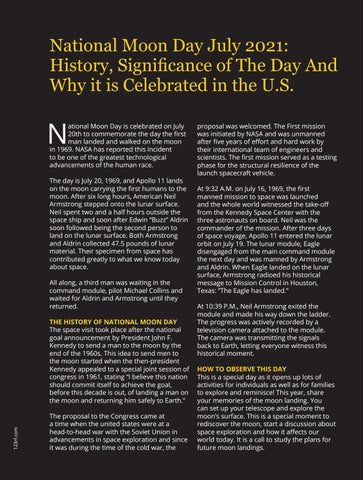National Moon Day July 2021: History, Significance of The Day And Why it is Celebrated in the U.S.
N
ational Moon Day is celebrated on July 20th to commemorate the day the first man landed and walked on the moon in 1969. NASA has reported this incident to be one of the greatest technological advancements of the human race. The day is July 20, 1969, and Apollo 11 lands on the moon carrying the first humans to the moon. After six long hours, American Neil Armstrong stepped onto the lunar surface. Neil spent two and a half hours outside the space ship and soon after Edwin “Buzz” Aldrin soon followed being the second person to land on the lunar surface. Both Armstrong and Aldrin collected 47.5 pounds of lunar material. Their specimen from space has contributed greatly to what we know today about space. All along, a third man was waiting in the command module, pilot Michael Collins and waited for Aldrin and Armstrong until they returned.
123rf.com
THE HISTORY OF NATIONAL MOON DAY The space visit took place after the national goal announcement by President John F. Kennedy to send a man to the moon by the end of the 1960s. This idea to send men to the moon started when the then-president Kennedy appealed to a special joint session of congress in 1961, stating “I believe this nation should commit itself to achieve the goal, before this decade is out, of landing a man on the moon and returning him safely to Earth.” The proposal to the Congress came at a time when the united states were at a head-to-head war with the Soviet Union in advancements in space exploration and since it was during the time of the cold war, the
proposal was welcomed. The First mission was initiated by NASA and was unmanned after five years of effort and hard work by their international team of engineers and scientists. The first mission served as a testing phase for the structural resilience of the launch spacecraft vehicle. At 9:32 A.M. on July 16, 1969, the first manned mission to space was launched and the whole world witnessed the take-off from the Kennedy Space Center with the three astronauts on board. Neil was the commander of the mission. After three days of space voyage, Apollo 11 entered the lunar orbit on July 19. The lunar module, Eagle disengaged from the main command module the next day and was manned by Armstrong and Aldrin. When Eagle landed on the lunar surface, Armstrong radioed his historical message to Mission Control in Houston, Texas: “The Eagle has landed.” At 10:39 P.M., Neil Armstrong exited the module and made his way down the ladder. The progress was actively recorded by a television camera attached to the module. The camera was transmitting the signals back to Earth, letting everyone witness this historical moment. HOW TO OBSERVE THIS DAY This is a special day as it opens up lots of activities for individuals as well as for families to explore and reminisce! This year, share your memories of the moon landing. You can set up your telescope and explore the moon’s surface. This is a special moment to rediscover the moon, start a discussion about space exploration and how it affects our world today. It is a call to study the plans for future moon landings.




















